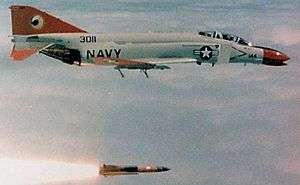MA-31
The MA-31 was a conversion of the Kh-31 anti-ship missile, developed by the Soviet Union during the 1980s, for use as a target drone by the United States Navy. Although the missile proved successful in this role, political complications resulted in the type being only an interim solution, and only a small number of the missiles were acquired.
| MA-31 | |
|---|---|
 | |
| Type | Target drone |
| Place of origin | Russia United States |
| Service history | |
| In service | 1996-2007 |
| Used by | United States Navy |
| Production history | |
| Manufacturer | Boeing, Zvezda-Strela |
| Specifications | |
| Mass | 1,300 pounds (590 kg) |
| Length | 15 ft (4.7 m) |
| Diameter | 14.2 inches (360 mm) |
| Engine | Solid fuel rocket in initial stage, ramjet for rest of trajectory |
| Wingspan | 36 inches (910 mm) |
Operational range | 31 mi (50 km) |
| Maximum speed | Mach 3.5 |
Launch platform | F-4 Phantom II |
Kh-31 development
The Kh-31 missile was developed by Zvezda-Strela in the Soviet Union starting in 1977 for service as a long-range anti-ship missile and anti-radiation missile, first being flown in 1982.[1] Derived from the P-270 Moskit missile,[1] the Kh-31 is conventional in shape, and has cruciform fins made from titanium,[2] with a rocket-ramjet propulsion system providing thrust.[1]
MA-31 history
Following the cancellation of the AQM-127 SLAT target drone program, a requirement for a new high-speed target to replace the MQM-8 Vandal still existed.[3] In an unusual turn of events, the U.S. Navy chose to acquire examples of the Kh-31 missile - the actual threat the drone was intended to simulate[3] - as an interim solution pending the development of an all-new design.[4] In 1995, a contract was awarded to McDonnell Douglas for evaluation of the Kh-31 in the Supersonic Sea-Skimming Target role.[1]
An initial small batch of missiles were acquired,[5] being delivered from the manufacturer as "green" shells, without electronics,[6] to Boeing, which had acquired McDonnell Douglas, in the US for modification and conversion to U.S. Navy standards, including the installation of tracking, telemetry and range-safety systems.[7] The MA-31 was equipped for launch from the QF-4 Phantom II aircraft, and it was proposed to develop a compatible launcher for the F-16N Fighting Falcon.[2]
Designated MA-31 in US service, the first launch of the missile took place in August 1996.[7] Evaluated against an improved MQM-8, the MA-31 proved superior and a contract for 34 production missiles was placed in 1999.[8]
At this point, politics intervened in the process, with the Russian Duma refusing export clearance for the missiles.[5] Boeing proposed a further-modified version of the missile, with improved guidance and longer range,[7] however the MA-31 program went no further, and the last missiles in the U.S. Navy's inventory were expended in 2007.[9]
The Navy would finally receive a definitive Supersonic Sea-Skimming Target, replacing the MA-31 and the MQM-8, in the form of the GQM-163 Coyote, which entered service during 2007.[10]
References
Notes
- Friedman 2006, pp.534
- Braucksick 2004
- Parsch and Caston 2006
- Goebel 2010
- Report of the Defense Science Board Task Force on Aerial Targets, Office of the Under Secretary of Defense for Acquisition, Technology, and Logistics, pp. 10, 56, archived from the original on 2016-03-03, retrieved 2011-01-05
- Smith 2004, p.61.
- Parsch 2008
- Contracts for Thursday, December 16, 1999, US Department of Defense, 1999-12-16
- Buckley 2007
- Parsch 2007
Bibliography
- Braucksick, Ken (2004-11-17), MA-31 Target Vehicle OVERVIEW, NDIA, archived from the original on 2011-05-22. Sales pitch from Boeing, has useful diagrams of flight profiles etc
- Buckley, Capt. Pat (2007-10-31), U.S. Navy Aerial Target Systems (Presented to 45th Annual NDIA Symposium) (PDF), US Navy, archived from the original (PDF) on 2011-05-22
- Goebel, Greg (2010). "Modern US Target Drones". Unmanned Aerial Vehicles. vectorsite.net. Retrieved 2010-12-31.
- Friedman, Norman (2006), The Naval Institute Guide to World Naval Weapon Systems (5th ed.), Naval Institute Press, ISBN 978-1-55750-262-9
- Parsch, Andreas; Craig Caston (2006). "Martin Marietta AQM-127 SLAT". Directory of U.S. Military Rockets and Missiles. designation-systems.net. Retrieved 2011-01-05.
- Parsch, Andreas (2007). "Orbital Sciences GQM-163 Coyote". Directory of U.S. Military Rockets and Missiles. designation-systems.net. Retrieved 2011-01-05.
- Parsch, Andreas (2008). "Boeing/Zvezda-Strela MA-31". Directory of U.S. Military Rockets and Missiles. designation-systems.net. Retrieved 2011-01-05.
- Smith, Charles Robinson (2004). Deception: How Clinton Sold America Out To The Chinese Military. Columbus, OH: Pine Lake Media. ISBN 0-9761168-0-4.